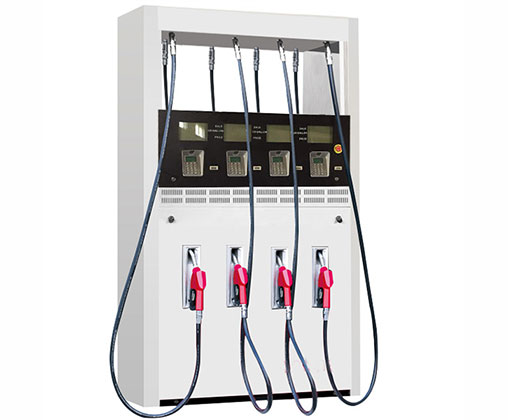Fuel Dispensers
Introduction:
The term "fuel dispenser," also known as a gas pump or petrol pump, refers to a sophisticated piece of equipment designed for the precise dispensing of liquid fuels into motor vehicles. At its core, a fuel dispenser is a comprehensive system integrating a liquid volume flow meter, various supplementary components, and auxiliary mechanisms to ensure accurate measurement and safe fuel delivery. These critical devices are ubiquitous in petrol stations worldwide.

Types of Fuel Dispensers: A Diverse Landscape
Fuel dispensers come in a variety of configurations, catering to different needs and applications. Here's a breakdown based on key characteristics:
Display Technology:
Mechanical Dispensers: These utilize traditional mechanical counters to display the amount of fuel dispensed. They are often found in older stations or regions with limited infrastructure.
Electronic/Computerized Dispensers: Modern dispensers use electronic displays and computer systems for enhanced accuracy, user interaction, and data management. They often include features like price per unit, total cost, and digital transaction records.
Number of Hoses (or "Guns"):
Single-Gun Dispensers: Designed to dispense only one type of fuel at a time.
Dual-Gun Dispensers: Allow dispensing of two types of fuel from the same unit, often found in stations with limited space.
Multi-Gun Dispensers: Capable of dispensing multiple fuel types simultaneously.
Pump Configuration:
In-Plane (Suction) Pump Dispensers: The pump unit is typically located within the dispenser cabinet. These rely on suction to draw fuel from underground tanks.
Submersible Pump Dispensers: Utilize pumps placed directly within the fuel storage tanks, pushing the fuel to the dispenser. These are generally more efficient, especially for high-volume stations.
Dispensing Speed:
Standard Dispensers: Designed for typical passenger vehicle refueling.
High-Speed Dispensers: Used for larger vehicles or areas with higher refueling demand, allowing for a quicker fuel delivery rate.
Explosion-Proof Classification:
Integrated Explosion-Proof Dispensers: All components of the system are enclosed within an explosion-proof housing.
Isolated Explosion-Proof Dispensers: Components that have the potential to generate sparks are separated into their own explosion-proof compartments.
Anatomy of a Fuel Dispenser: Core Components and Functions
Fuel dispensers are complex machines composed of various interacting components. Here’s a closer look at key elements:
Computer System/Control Unit: The brain of the dispenser. It manages dispensing operations, controls the display, stores data, and handles communication with payment systems. It triggers the fuel dispensing process based on the activation of the oil gun switch. The system also communicates with the counter sensor.
Oil Pump: The heart of the hydraulic system. Powered by an electric motor, it draws fuel from the storage tank and pushes it through the system towards the dispensing hose. It is the primary mechanism for moving the fuel.
Oil and Gas Separator: A crucial safety device ensuring precise fuel measurement. It removes any vaporized fuel (air/gas) mixed with the liquid fuel, preventing inaccurate readings at the flow meter. The removed gas is safely vented.
Flow Meter: This device accurately measures the volume of fuel passing through it. It’s the heart of the fuel measurement system, employing mechanical elements (turbines, pistons) to translate flow into a measurable quantity.
Counter Sensor/Encoder: This device converts the mechanical rotation of the flow meter into a digital signal that the computer can read, allowing for accurate measurement and display of the dispensed fuel quantity. Anti-cheating encoders are used to prevent tampering.
Solenoid Valve: An electronically controlled valve regulating the flow of fuel through the dispenser. The system uses two valves, to improve accuracy in quantitative refueling and prevent overfill.
Nozzle (Oil Gun): The device held by the user to direct fuel into the vehicle's tank. It includes a dispensing valve switch, a self-sealing mechanism to prevent drips, and a fuel delivery nozzle.
Nozzle Switch (Gun Switch): This component activates the dispensing process. When the nozzle is removed from its holster, the switch signals the computer to initiate the dispensing.
Additional Notes and Advanced Features:
Modern fuel dispensers are often equipped with more advanced features:
Payment Terminals: Integrated card readers or contactless payment systems.
Touch Screen Interfaces: For more intuitive user interaction.
Remote Monitoring: Connectivity to a central station for maintenance and diagnostics.
Automatic Temperature Compensation: To adjust for fuel volume changes due to temperature variations.
Enhanced Security Features: Tamper-proof mechanisms and data encryption.
This detailed explanation should help you with your understanding and optimization efforts. Let me know if you have other content you'd like to improve!
Previous : Air Vaporizer













Comments